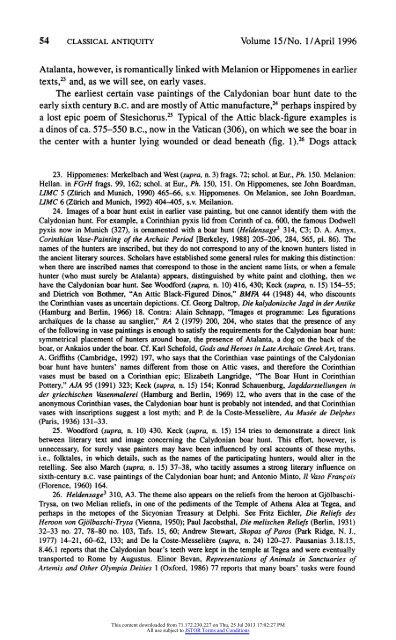Atalanta as Model: The Hunter and the Hunted - Robert Bedrosian's ...
Atalanta as Model: The Hunter and the Hunted - Robert Bedrosian's ...
Atalanta as Model: The Hunter and the Hunted - Robert Bedrosian's ...
Create successful ePaper yourself
Turn your PDF publications into a flip-book with our unique Google optimized e-Paper software.
54 CLASSICAL ANTIQUITY Volume 15/No. 1/April 1996<br />
<strong>Atalanta</strong>, however, is romantically linked with Melanion or Hippomenes in earlier<br />
texts,23 <strong>and</strong>, <strong>as</strong> we will see, on early v<strong>as</strong>es.<br />
<strong>The</strong> earliest certain v<strong>as</strong>e paintings of <strong>the</strong> Calydonian boar hunt date to <strong>the</strong><br />
early sixth century B.C. <strong>and</strong> are mostly of Attic manufacture,24 perhaps inspired by<br />
a lost epic poem of Stesichorus.25 Typical of <strong>the</strong> Attic black-figure examples is<br />
a dinos of ca. 575-550 B.C., now in <strong>the</strong> Vatican (306), on which we see <strong>the</strong> boar in<br />
<strong>the</strong> center with a hunter lying wounded or dead beneath (fig. 1).26 Dogs attack<br />
23. Hippomenes: Merkelbach <strong>and</strong> West (supra, n. 3) frags. 72; schol. at Eur., Ph. 150. Melanion:<br />
Hellan. in FGrH frags. 99, 162; schol. at Eur., Ph. 150, 151. On Hippomenes, see John Boardman,<br />
LIMC 5 (ZUrich <strong>and</strong> Munich, 1990) 465-66, s.v. Hippomenes. On Melanion, see John Boardman,<br />
LIMC 6 (Ztrich <strong>and</strong> Munich, 1992) 404-405, s.v. Meilanion.<br />
24. Images of a boar hunt exist in earlier v<strong>as</strong>e painting, but one cannot identify <strong>the</strong>m with <strong>the</strong><br />
Calydonian hunt. For example, a Corinthian pyxis lid from Corinth of ca. 600, <strong>the</strong> famous Dodwell<br />
pyxis now in Munich (327), is ornamented with a boar hunt (Heldensage3 314, C3; D. A. Amyx,<br />
Corinthian V<strong>as</strong>e-Painting of <strong>the</strong> Archaic Period [Berkeley, 1988] 205-206, 284, 565, pl. 86). <strong>The</strong><br />
names of <strong>the</strong> hunters are inscribed, but <strong>the</strong>y do not correspond to any of <strong>the</strong> known hunters listed in<br />
<strong>the</strong> ancient literary sources. Scholars have established some general rules for making this distinction:<br />
when <strong>the</strong>re are inscribed names that correspond to those in <strong>the</strong> ancient name lists, or when a female<br />
hunter (who must surely be <strong>Atalanta</strong>) appears, distinguished by white paint <strong>and</strong> clothing, <strong>the</strong>n we<br />
have <strong>the</strong> Calydonian boar hunt. See Woodford (supra, n. 10) 416, 430; Keck (supra, n. 15) 154-55;<br />
<strong>and</strong> Dietrich von Bothmer, "An Attic Black-Figured Dinos," BMFA 44 (1948) 44, who discounts<br />
<strong>the</strong> Corinthian v<strong>as</strong>es <strong>as</strong> uncertain depictions. Cf. Georg Daltrop, Die kalydonische Jagd in derAntike<br />
(Hamburg <strong>and</strong> Berlin, 1966) 18. Contra: Alain Schnapp, "Images et programme: Les figurations<br />
archaiques de la ch<strong>as</strong>se au sanglier," RA 2 (1979) 200, 204, who states that <strong>the</strong> presence of any<br />
of <strong>the</strong> following in v<strong>as</strong>e paintings is enough to satisfy <strong>the</strong> requirements for <strong>the</strong> Calydonian boar hunt:<br />
symmetrical placement of hunters around boar, <strong>the</strong> presence of <strong>Atalanta</strong>, a dog on <strong>the</strong> back of <strong>the</strong><br />
boar, or Ankaios under <strong>the</strong> boar. Cf. Karl Schefold, Gods <strong>and</strong> Heroes in Late Archaic Greek Art, trans.<br />
A. Griffiths (Cambridge, 1992) 197, who says that <strong>the</strong> Corinthian v<strong>as</strong>e paintings of <strong>the</strong> Calydonian<br />
boar hunt have hunters' names different from those on Attic v<strong>as</strong>es, <strong>and</strong> <strong>the</strong>refore <strong>the</strong> Corinthian<br />
v<strong>as</strong>es must be b<strong>as</strong>ed on a Corinthian epic; Elizabeth Langridge, "<strong>The</strong> Boar Hunt in Corinthian<br />
Pottery," AJA 95 (1991) 323; Keck (supra, n. 15) 154; Konrad Schauenburg, Jagddarstellungen in<br />
der griechischen V<strong>as</strong>enmalerei (Hamburg <strong>and</strong> Berlin, 1969) 12, who avers that in <strong>the</strong> c<strong>as</strong>e of <strong>the</strong><br />
anonymous Corinthian v<strong>as</strong>es, <strong>the</strong> Calydonian boar hunt is probably not intended, <strong>and</strong> that Corinthian<br />
v<strong>as</strong>es with inscriptions suggest a lost myth; <strong>and</strong> P. de la Coste-Messeliere, Au Musee de Delphes<br />
(Paris, 1936) 131-33.<br />
25. Woodford (supra, n. 10) 430. Keck (supra, n. 15) 154 tries to demonstrate a direct link<br />
between literary text <strong>and</strong> image concerning <strong>the</strong> Calydonian boar hunt. This effort, however, is<br />
unnecessary, for surely v<strong>as</strong>e painters may have been influenced by oral accounts of <strong>the</strong>se myths,<br />
i.e., folktales, in which details, such <strong>as</strong> <strong>the</strong> names of <strong>the</strong> participating hunters, would alter in <strong>the</strong><br />
retelling. See also March (supra, n. 15) 37-38, who tacitly <strong>as</strong>sumes a strong literary influence on<br />
sixth-century B.C. v<strong>as</strong>e paintings of <strong>the</strong> Calydonian boar hunt; <strong>and</strong> Antonio Minto, II V<strong>as</strong>o Francois<br />
(Florence, 1960) 164.<br />
26. Heldensage3 310, A3. <strong>The</strong> <strong>the</strong>me also appears on <strong>the</strong> reliefs from <strong>the</strong> heroon at Gjl6b<strong>as</strong>chi<br />
Trysa, on two Melian reliefs, in one of <strong>the</strong> pediments of <strong>the</strong> Temple of A<strong>the</strong>na Alea at Tegea, <strong>and</strong><br />
perhaps in <strong>the</strong> metopes of <strong>the</strong> Sicyonian Tre<strong>as</strong>ury at Delphi. See Fritz Eichler, Die Reliefs des<br />
Heroon von Gjolb<strong>as</strong>chi-Trysa (Vienna, 1950); Paul Jacobsthal, Die melischen Reliefs (Berlin, 1931)<br />
32-33 no. 27, 78-80 no. 103, Tafs. 15, 60; Andrew Stewart, Skop<strong>as</strong> of Paros (Park Ridge, N. J.,<br />
1977) 14-21, 60-62, 133; <strong>and</strong> De la Coste-Messelibre (supra, n. 24) 120-27. Pausani<strong>as</strong> 3.18.15,<br />
8.46.1 reports that <strong>the</strong> Calydonian boar's teeth were kept in <strong>the</strong> temple at Tegea <strong>and</strong> were eventually<br />
transported to Rome by Augustus. Elinor Bevan, Representations of Animals in Sanctuaries of<br />
Artemis <strong>and</strong> O<strong>the</strong>r Olympia Deities 1 (Oxford, 1986) 77 reports that many boars' tusks were found<br />
This content downloaded from 71.172.230.227 on Thu, 25 Jul 2013 17:02:27 PM<br />
All use subject to JSTOR Terms <strong>and</strong> Conditions
















